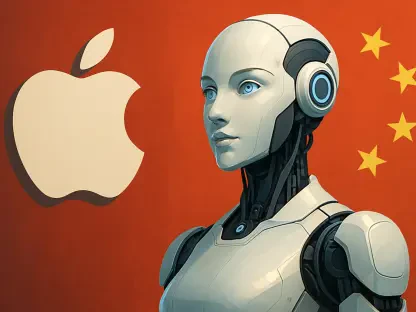Imagine a world where a simple text input can yield responses so nuanced and insightful that they rival human conversation—yet this is no longer a distant dream but a tangible reality in 2025. Generative AI chatbots have surged to the forefront of technological innovation, reshaping how individuals interact with machines and transforming industries from education to customer service. These tools, powered by advanced algorithms, promise to streamline communication and enhance productivity, but their rapid adoption also raises critical questions about dependency and ethical use. This review delves into the mechanics, applications, and implications of these chatbots, offering a comprehensive look at their role in the modern digital landscape.
Core Features and Technical Underpinnings
Mastering Language Through Advanced Models
At the heart of generative AI chatbots lies their ability to understand and produce human-like text, a feat achieved through sophisticated natural language processing frameworks. Utilizing transformer models, these systems analyze vast datasets to grasp context, tone, and intent, enabling them to craft responses that feel remarkably conversational. Their performance shines in varied settings, whether providing quick answers in casual exchanges or tackling intricate queries in professional domains, demonstrating a versatility that sets them apart from earlier chatbot iterations.
However, this linguistic prowess is not without flaws. While the technology excels in generating coherent dialogue, it occasionally struggles with nuanced cultural references or highly specialized topics, leading to responses that can seem generic or off-mark. Continuous refinement of these models remains essential to bridge gaps in contextual accuracy and ensure broader applicability across diverse user interactions.
Learning and Adapting in Real Time
Another defining trait of these chatbots is their capacity to evolve through user engagement, leveraging data feedback to refine their responses over time. This adaptive learning allows them to tailor interactions to individual preferences, offering personalized suggestions or recalling past conversations for continuity. Such features enhance user experience by making exchanges feel more relevant and intuitive, a key advantage in both personal and professional contexts.
Despite these strengths, adaptive learning has its limits. The quality of personalization often depends on the volume and diversity of input data, meaning that less frequent users may encounter less customized outputs. Moreover, maintaining conversation depth during prolonged interactions can be challenging, as the system may revert to repetitive patterns if not regularly updated with fresh data.
Cutting-Edge Developments and Emerging Patterns
Integration into Everyday Tools
Recent advancements have seen generative AI chatbots seamlessly embedded into educational and professional platforms, marking a significant shift in their utility. From virtual tutors aiding students with tailored study plans to workplace assistants streamlining workflows, these integrations reflect a trend toward practical, user-centric applications. The focus is increasingly on enhancing human effort rather than replacing it, a direction that promises to redefine productivity standards.
A notable pattern is the rise of interactive learning modes, where chatbots guide users through problem-solving rather than supplying direct answers. This approach fosters critical thinking and skill development, aligning with a growing emphasis on balanced technology use. As these innovations unfold, they highlight the potential for chatbots to become indispensable partners in knowledge acquisition and task management.
Shifting User Dynamics
User behavior is also evolving alongside these technological strides, with greater awareness of the need to avoid over-reliance on AI. Many individuals now approach chatbots as supplementary tools, consulting them to refine ideas or uncover blind spots after initial independent efforts. This cautious engagement reflects a broader societal push toward maintaining cognitive autonomy while still harnessing the benefits of automated assistance, a balance that will likely shape future adoption trends.
Practical Implementations Across Sectors
Transforming Key Industries
Generative AI chatbots have found robust applications in fields like education, customer service, and content creation, proving their versatility. In educational settings, platforms such as Google’s LearnLM offer personalized tutoring, adapting to individual learning paces to optimize outcomes. Similarly, customer service operations benefit from chatbots that handle inquiries with speed and precision, freeing human agents for more complex tasks and enhancing overall efficiency.
In content creation, tools like Lex stand out by collaborating with users to polish writing skills without taking over the creative process. These implementations underscore how chatbots can support diverse needs, catering to students seeking academic growth and professionals aiming to boost output. Their ability to adapt to specific industry demands makes them a valuable asset in driving innovation and accessibility.
Empowering Diverse User Groups
Beyond specific sectors, these chatbots serve a wide array of users by accelerating learning and productivity in unique ways. For instance, Study Mode in certain platforms uses guided questioning to deepen critical thinking among learners, ensuring active engagement with material. Meanwhile, professionals leverage these tools for brainstorming and refining strategies, tapping into AI insights to complement their expertise and achieve better results in less time.
Hurdles and Areas of Concern
Technical and Accuracy Challenges
Despite their capabilities, generative AI chatbots face significant technical obstacles, particularly in ensuring response accuracy. Misinterpretations of context or intent can lead to irrelevant or incorrect outputs, undermining trust in critical applications. Addressing these issues requires ongoing improvements in model training and error detection to minimize misunderstandings and enhance reliability across varied scenarios.
Cognitive and Ethical Risks
A deeper concern lies in the cognitive risks associated with overuse, often referred to as “cognitive debt.” Research indicates that excessive dependence on AI can erode skills like memory and analytical thinking, particularly among younger users. Studies from reputable institutions have highlighted declines in confidence and writing ability among heavy users, signaling a need for mindful interaction to preserve mental agility.
Ethically, the technology raises alarms around data privacy and the potential spread of misinformation. Without stringent safeguards, sensitive user information could be mishandled, while unchecked outputs risk amplifying false narratives. Efforts to mitigate these dangers include stricter regulatory frameworks and better design practices, alongside educating users on responsible engagement to curb misuse.
Looking Ahead to New Horizons
Envisioning Deeper Integration
The trajectory of generative AI chatbots points toward even greater integration into daily life, with the potential to become fixtures in education systems and personal routines. Future developments may see these tools embedded in smart environments, offering real-time assistance tailored to situational needs. Such advancements could redefine how knowledge is accessed and applied, creating seamless bridges between human intent and digital support.
Anticipating Breakthroughs
Potential breakthroughs loom on the horizon, particularly in areas like emotional intelligence, where chatbots might better detect and respond to user sentiment. Enhanced critical thinking support is also a likely focus, with systems designed to challenge assumptions and foster deeper analysis. These innovations could elevate chatbots from mere tools to true intellectual companions, capable of nuanced interaction that mirrors human empathy and reasoning.
Societal and Long-Term Impacts
Over the long term, the societal impact of these chatbots could be profound, reshaping learning environments and workplace dynamics. As they become more adept at supporting skill development, traditional models of education and professional training may shift toward hybrid approaches that blend human and AI input. Responsible usage trends will play a critical role in ensuring that these changes prioritize human growth over technological convenience, guiding development in a direction that benefits society as a whole.
Reflecting on the Journey and Next Steps
Looking back, this exploration of generative AI chatbots revealed a technology that stands as both a remarkable achievement and a source of caution. Their conversational abilities impress, often rivaling human interaction, yet technical inaccuracies and ethical concerns underscore the need for vigilance. The dual nature of their impact—capable of enhancing intellect or fostering dependency—emerges as a central theme of the assessment.
Moving forward, stakeholders must prioritize strategies that maximize benefits while addressing pitfalls. Developers should focus on refining accuracy and embedding ethical safeguards to protect user data and curb misinformation. Educators and users alike ought to advocate for training programs that emphasize strategic AI engagement, ensuring it serves as a partner rather than a crutch. By fostering a culture of intentional use, society can harness the transformative power of these chatbots to elevate human potential in education, work, and beyond.









